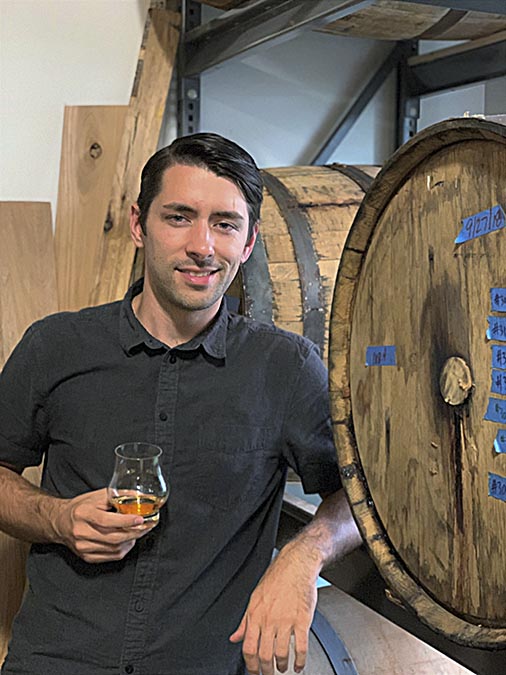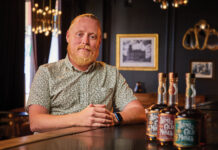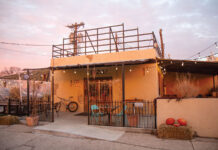
How does a degree in mathematics and computer science lead to distilling? What if you also studied religion, monasticism, ancient Egyptian language, culture, folklore and food pathways in archaeology at the University of Pennsylvania? Such is the background of distiller and Philadelphia native Andrew Lohfeld.
An intro to homebrewing though a friend set Lohfeld on a path brewing beer, cider, mead and sake, as well as some dairy production in yogurt and cheese. As with many distillers, his original goal was to open a brewery. While job hunting, he landed a distillery internship in New York City at cult craft distillery, Kings County Distillery (ADI’s 2016 Craft Distillery of the Year). This changed his course again, as he became one of their distillers in 2013.
Louisiana native Patrick Hernandez was Lohfeld’s fellow college graduate and freshman-year hallmate, who also just happened to move to NYC. They had lost touch post-graduation but reconnected at a friend’s wedding and discovered they lived only blocks from each other. Weeks later, Lohfeld shared his distillery vision and desire to create a unique rum. They connected on the vision, which ambitiously included moving to New Orleans and growing their own sugarcane. After a research trip together, the dream began to solidify into reality. Eventually, they opened Roulaison Distilling in December of 2016 after more than a year and a half of permitting and construction.
Producing a traditional pot-distilled (white) rum, an overproof rum, a barrel-aged rum, a rum-based herbal liqueur and a few single barrels and limited edition rhum agricole, they have been pushing boundaries in U.S. rum and sugarcane.
Here’s our interview with Lohfeld, Roulaison’s distiller and vice president of the Louisiana Distillers Guild.
What led you to distilling and spirits?
I dived deep into the spirits industry after graduating from college. I always get surprised expressions from folks when they ask about what I studied in school, too, because it’s definitely not what people expect — I graduated with a degree in logic, information and computation, which is a fancy way of saying math and computer science. Basically, I caught the homebrewing bug, hard, while at school and ended up spending many of my weekends and most of my summers brewing beer. Plus, I have always had a big passion for history and botany floating in the periphery and, being technically minded, have always liked to know how things were made and what inspired their form and function.
Right before graduating, I decided to forgo looking for a job in what would have probably been tech or finance and attempt to pursue brewing full-time, the intent being to gain some hands-on experience before opening up a place of my own. Of course, this was way after the point when any brewery in their right mind would hire a guy with just homebrewing experience, so generally I had a tough time actually finding anyone to hire me on the brewing side of things. Luckily, with the big boom in craft spirits, I noticed there were a lot more opportunities to get my foot in the door with distilling, so, knowing that whiskey was the next logical step after beer, I did what most recent grads living on the East Coast did — moved to New York City and persistently bothered enough unsuspecting businesses until one gave me a job. Thankfully for me, that was at Kings County Distillery, where everyone was extremely supportive, very open about their process and just generally great to be around.
What spirits do you consider your flagship spirits and why are you distilling those particular spirits?
Well, rum, definitely. For one, Roulaison is a single-spirit distillery, so that’s pretty much the only thing we do. My preference had always been to do one thing, dive deep and really try to do it justice. The longer I worked at Kings, the more I noticed how cramped the whiskey category was getting and just how difficult it was to create something that was innovative and unique under all of the category’s regulations. I knew how underrepresented rum was in the States, even though we were historically a major rum-producing country and still have a vibrant sugarcane industry. I thought that with such a wide array of ways to produce rum, I could create something that was truly unique, that could have an expressive sense of place by working with local sugarcane and that could allow me to work toward making a lasting impact on American rum production.
Tell us about your distilling process — what is unique to what you do?
A big part of who we are comes from our sugarcane. Even though we’re extremely tiny when it comes to our production volume, we’re still working closely with our local mill to get the best molasses possible. They specifically set aside for us what’s called second-run molasses, which they pull off from the middle of the sugar-production process. It’s less refined than your standard blackstrap and has a higher sugar content. I like it because it’s closer to the type of molasses that you’d see in historic rum production, before the more modern and more efficient refining processes were developed for modern blackstrap. During harvest, the roulaison of our namesake, we even have the opportunity to use fresh cane juice for the production of the rare batch of rhum agricole as well, which we’ve experimented with and hope to expand on more in the future.
From fermentation onward, things get a little wild — literally. We don’t pasteurize our molasses prior to fermentations, and we let them run long in open-air vessels. We incorporate dunder — or what I like to call “American dunder,” since it’s the equivalent to whiskey’s sour mash — and we inoculate with two separate yeasts: a high-ester beer strain and Brettanomyces. This is all to give us this wide and wild palette of flavors that we can use to layer loads of complexity into our final product. We finish off production in simple copper pot stills to retain as much of that natural flavor and complexity as we possibly can. A small percentage of our rum also goes through the “queen’s share” process, where we redistill our heads and tails with additional dunder — this time “true” or “Jamaican-style” dunder (i.e., muck, i.e., aged, secondarily fermented stillage) — to give us a big-bouqueted, powerhouse of a rum that we lay down for extra aging.
How does living in New Orleans determine the style or focus of your business?
New Orleans is much more than “a drinking city” or “the birthplace of the American Cocktail.” It is a city of artistry and authenticity across every aspect of life. There’s history, music, culture and definitely cuisine. We want to be able to celebrate that and to share a bit of it all with the world, but we also know that it needs to be preserved and respected. The way I see it, if we’re pulling inspiration from New Orleans, we also need to be inspirational for others and add to the uniqueness that is the city rather than take away from it. That should be reflected in the products we make here. New Orleans is full of passionate people, and we need to do our part by embracing the history and pouring our passion and soul into our own products. Being in a place with historic sugarcane ties alone is not enough; more importantly, we have to be unique and definitely have to bring flavor. Nothing in New Orleans is bland.
How have you grown your brand at bars and beyond?
Persistence, engagement and a lot of legwork. Even as we expand into new markets, our primary focus is still New Orleans. There will always be new restaurants, new bars, new staff, new menus, new opportunities out there, and we just have to be ready when they come up. Because it’s our home market, we already know it well, and we have the opportunities to meet people and follow up firsthand. So, as a small brand like us, there’s always more room to grow here.
What advice would you give to fellow distillers looking to get their spirits into bars? What has worked for you?
You are your own biggest asset. You’re going to be the most passionate about your spirits, you’re going to know the most about how they’re made, and you’re going to be able to tell your story better than anybody else can. That’s your biggest advantage over the more typical corporate brand reps. As long as you’re patient and you’re building good relationships with your buyers and bartenders, you’ll eventually see that translate into growth. It also means that you need to produce a product you truly believe in.
What small-batch spirits are exciting you most right now? Or, if you prefer, what is exciting you most about the current climate in spirits and cocktails?
I’m especially excited to see where we American distillers can take cane juice rums in the next couple of years, but generally I really enjoy seeing the growth of all the more fringe styles of rum out there. Cane juice, clairin, pot-still and high-ester rums are starting to garner a lot more press and are popping up in bars across the country. I also think the push for more transparency in spirits and a better, more structured rum category could be extremely important in helping smaller producers differentiate themselves in the market.








